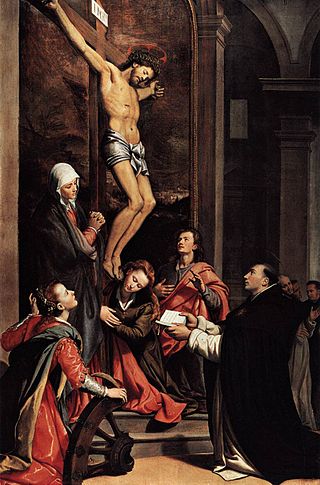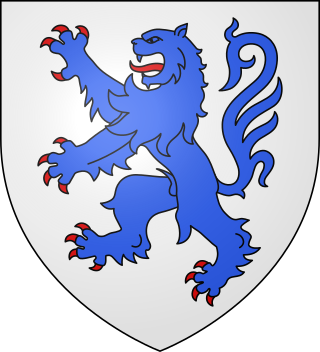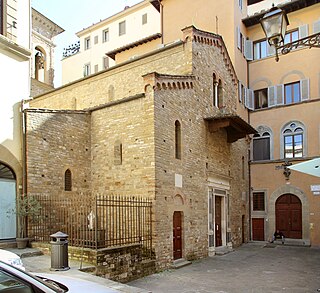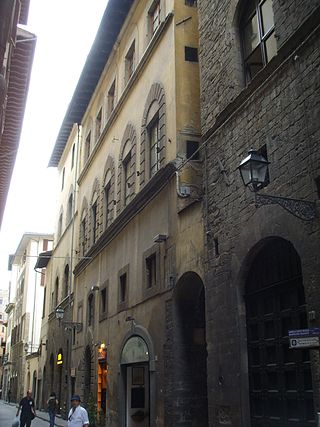The tower
Built by the Buondelmonti around 1280, it belonged to Niccolò Acciaiuoli, Grand Siniscalco of the Kingdom of Naples, who included it in his palace in 1341, becoming one of the oldest buildings owned by the powerful Florentine family of Acciaiuoli. At the end of the 16th century, it passed to the Colle di Val d'Elsa family of Usimbardi (family). [2]
In 1864 and 1920, the tower underwent restoration works (those of the second decade of the twentieth century directed by architect Ugo Giusti) that privileged the medieval components and determined its current appearance.
The tower is among the tallest in Florence: narrow and covered by the typical stone filaretto, it has a door surmounted by a monolithic architrave on two moulded corbels. Above it opens a ring (architecture) with a pointed arch.
The palace
Also known as the Grand Siniscalco Palace from the name of its founder, it is built of stone with large, regular mouldings on the ground floor and filaretto stone on the upper floors. It has the appearance of a fortress, rather austere, and is reminiscent of the Bargello. Three orders of arched windows, emphasised by string-course cornices, punctuate the façade, which must have been among the most majestic in the city at the time. [2]
The façade also bears the coat of arms of the Carthusian monks of Niccolò Acciaiuoli, which features two lions holding lily flags; in the centre is the cross of Calvary and the inscription Certosa recalling the foundation of the Certosa di Firenze on the initiative of Acciaiuoli, who donated this very palace for the use of the Carthusian monks.
There also rests a plaque from 1930 with a part in Italian commemorating the Acciaiuoli family and one in Latin describing the location of the palazzo, as written in the Florentine Archive of the «Charterhouse Papers».
All’interno corre una scala in legno alla quale si accede dal palazzo. Sulla sommità si trovano due terrazze panoramiche a livelli diversi.
Alla morte di Niccolò il palazzo passò quindi ai monaci della Certosa, che lo possedettero fino alla soppressione degli ordini monastici all’inizio dell’Ottocento. [2] Venne messo in vendita e passò in diverse mani, tra le quali i Burresi Pettini furono gli ultimi, che ancora lo posseggono e lo usano in parte per un’attività alberghiera.

The Ponte Vecchio is a medieval stone closed-spandrel segmental arch bridge over the Arno, in Florence, Italy. The only bridge in Florence spared from destruction during World War II, it is noted for the shops built along it; building shops on such bridges was once a common practice. Butchers, tanners, and farmers initially occupied the shops; the present tenants are jewellers, art dealers, and souvenir sellers. The Ponte Vecchio's two neighbouring bridges are the Ponte Santa Trinita and the Ponte alle Grazie.

The Pazzi were a powerful family in the Republic of Florence. Their main trade during the fifteenth century was banking. In the aftermath of the Pazzi conspiracy in 1478, members of the family were banished from Florence and their property was confiscated; the family name and coat-of-arms were permanently suppressed by order of the Signoria.

The Palazzo Pitti, in English sometimes called the Pitti Palace, is a vast, mainly Renaissance, palace in Florence, Italy. It is situated on the south side of the River Arno, a short distance from the Ponte Vecchio. The core of the present palazzo dates from 1458 and was originally the town residence of Luca Pitti, an ambitious Florentine banker.

Santi di Tito was one of the most influential and leading Italian painters of the proto-Baroque style – what is sometimes referred to as "Counter-Maniera" or Counter-Mannerism.

The Acciaioli family, also spelled Acciaiuoli, Accioly, Acciajuoli or Acioli was an important Italian noble family from Florence, whose members were the ruling Dukes of Athens.

The Church of Santi Apostoli is a Romanesque-style, Roman Catholic church in the historic center of Florence, in the Tuscany region of Italy. It is among the oldest church buildings in Florence.

Borgo is the 14th rione of Rome, Italy. It is identified by the initials R. XIV and is included within Municipio I.

Palazzo Mozzi or Palazzo de' Mozzi is an early Renaissance palace, located at the end of the Piazza de' Mozzi that emerges from Ponte alle Grazie and leads straight to the palace where via San Niccolò becomes via de' Bardi in the Quartiere of Santo Spirito in the Oltrarno section of Florence, region of Tuscany, Italy. The 13th-century palace housed the gallery of the highly successful antiquarian Stefano Bardini, of which the remnants were left to the commune, where they assembled the Museo Bardini or Mozzi Bardini, displaying Florentine art and artifacts up to the early Renaissance. The gardens elaborated against the hillside behind the palace were added mainly by Bardini.

Bernardino Poccetti, also known as Barbatelli, was an Italian Mannerist painter and printmaker of etchings.

Galluzzo is part of quartiere 3 of the Italian city of Florence, Italy, located in the southern extremity of the Florentine commune. It is known for the celebrated Carthusian monastery, the Galluzzo or Florence Charterhouse, which was founded in 1342 by Niccolò Acciaioli.

Florence Charterhouse is a charterhouse, or Carthusian monastery, located in the Florence suburb of Galluzzo, in central Italy. The building is a walled complex located on Monte Acuto, at the point of confluence of the Ema and Greve rivers.

Angelo Acciaioli was an Italian Roman Catholic bishop from Florence.

Piazza della Repubblica is a city square in Florence, Italy. It was originally the site of the city's forum; then of its old ghetto, which was swept away during the improvement works, or Risanamento, initiated during the brief period when Florence was the capital of a reunited Italy—work that also created the city's avenues and boulevards. At that time, the Loggia del Pesce from the Mercato Vecchio was also moved to Piazza Ciompi. The square's Giubbe Rosse cafe has long been a meeting place for famous artists and writers, notably those of Futurism.

The Tower or Torre dei Rossi-Cerchi is a reconstructed medieval tower, now part of the Hotel Pitti Palace al Ponte Vecchio, located on Via Guicciardini, corner Borgo San Jacopo, in the Oltrarno district near the entrance to the Ponte Vecchio in Florence, region of Tuscany, Italy.

A ferro or ferro da facciata is an item of functional wrought-iron work on the façade of an Italian building. Ferri are a common feature of Medieval and Renaissance architecture in Lazio, Tuscany and Umbria. They are of three main types: ferri da cavallo have a ring for tethering horses, and are set at about 1.5 metres from the ground; holders for standards and torches are placed higher on the façade and on the corners of the building; arpioni have a cup-shaped hook or hooks to support cloth for shade or to be dried, and are set near balconies.

The Stinche Prison was a prison on Via Ghibellina in the city of Florence, Italy. It stood more or less on the site now occupied by the Teatro Verdi.

Borgo Santo Spirito is a street in Rome, Italy, important for historical and artistic reasons. From a historical point of view, it is considered the most interesting street in the Borgo district. Of medieval origin, it is linked to the foundation of the ancient fortified hospice for pilgrims from England, the Burgus Saxonum. The street houses the oldest Roman hospital, the Arcispedale di Santo Spirito in Saxia, which gave it its name. Heavily altered during the works for the opening of Via della Conciliazione, it nevertheless avoided the fate of the two parallel streets of Borgo Nuovo and Borgo Vecchio, both destroyed.

The Casa Acciaiuoli was one of the Acciaiuoli family's palaces in Florence, located at Borgo Santi Apostoli 10 corner Chiasso Cornino 1r.

The palazzo dell’Arcone di Piazza is a civil building in the historical centre of Florence, located at Piazza della Repubblica 5, corner Via degli Anselmi 2, Via Pellicceria, Via degli Strozzi 1- 2, Via de' Brunelleschi 5.

























